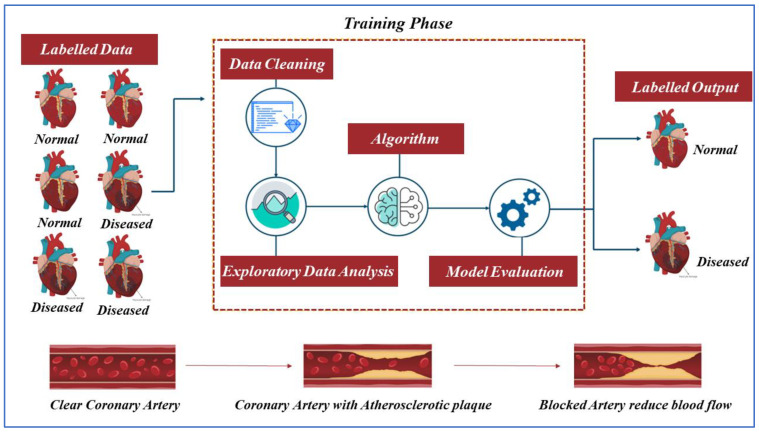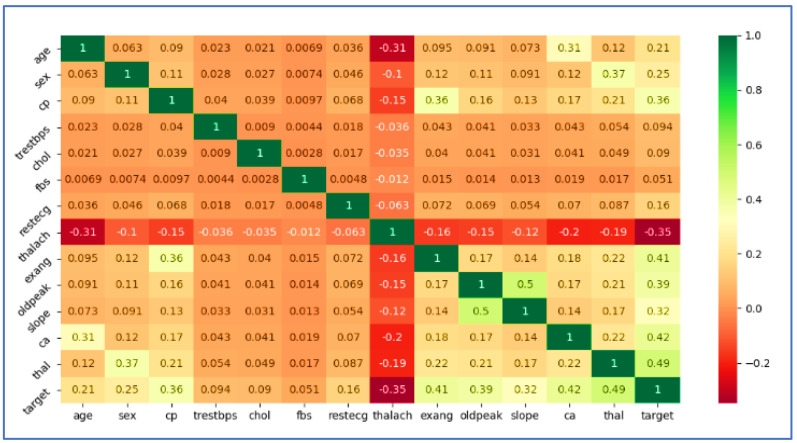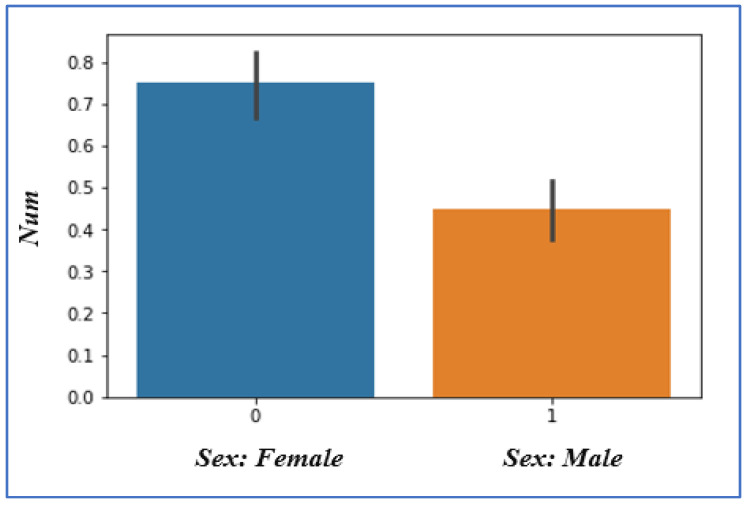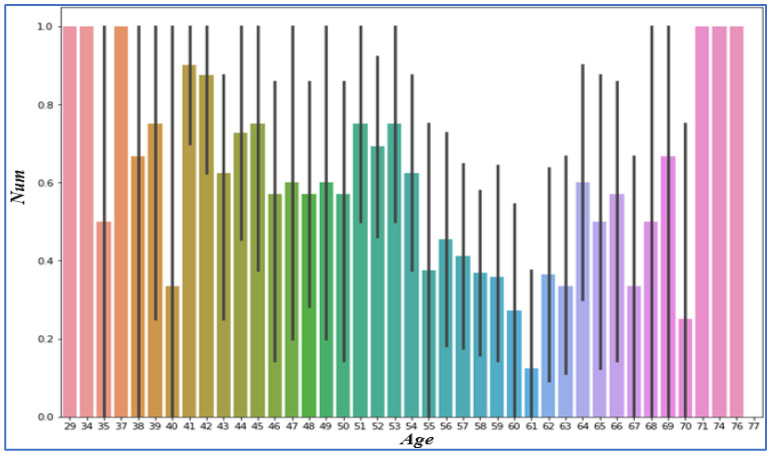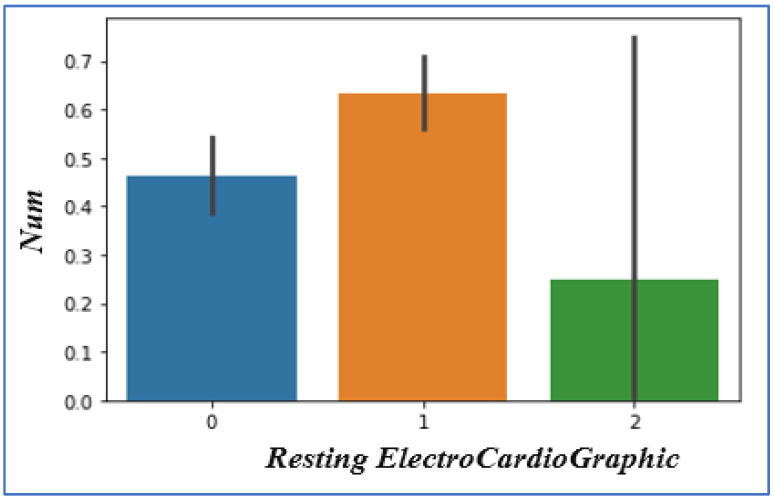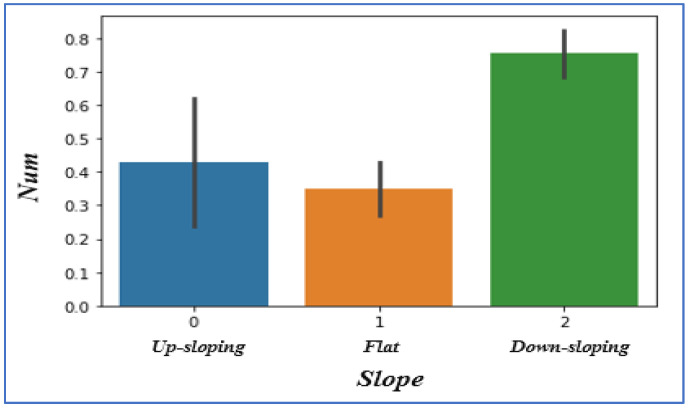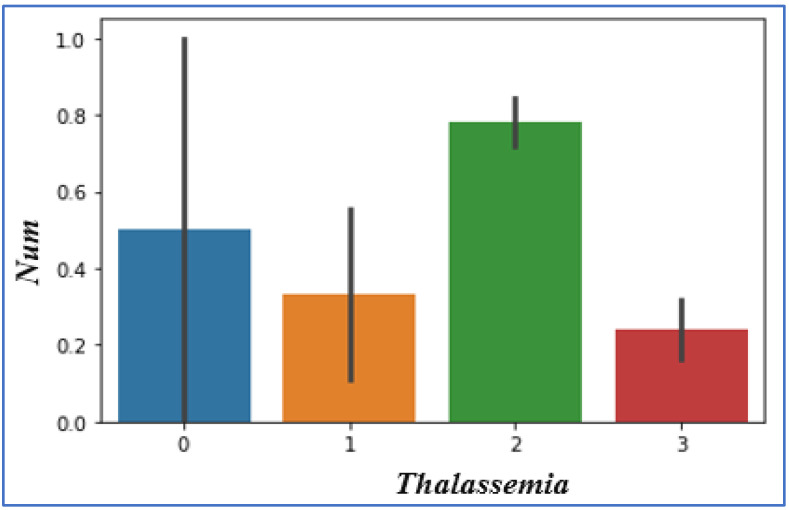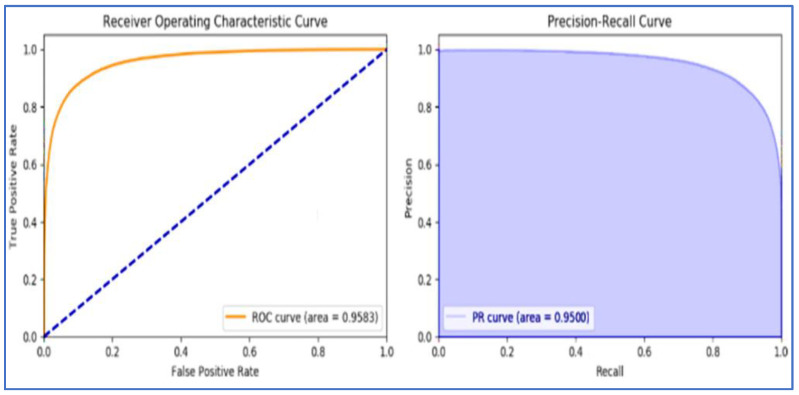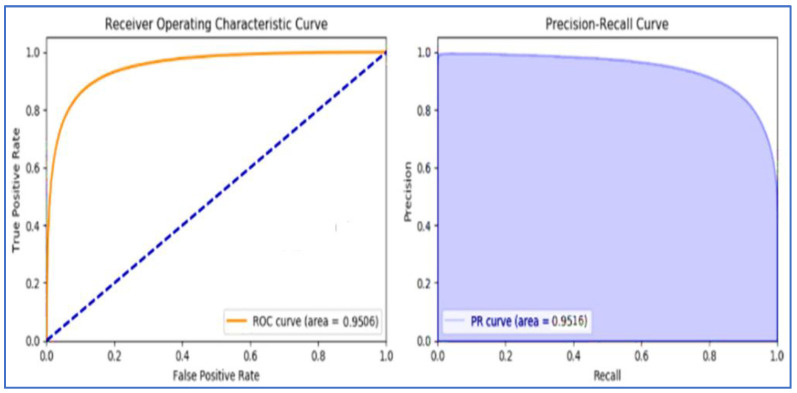Abstract
Coronary heart disease is one of the major causes of deaths around the globe. Predicating a heart disease is one of the most challenging tasks in the field of clinical data analysis. Machine learning (ML) is useful in diagnostic assistance in terms of decision making and prediction on the basis of the data produced by healthcare sector globally. We have also perceived ML techniques employed in the medical field of disease prediction. In this regard, numerous research studies have been shown on heart disease prediction using an ML classifier. In this paper, we used eleven ML classifiers to identify key features, which improved the predictability of heart disease. To introduce the prediction model, various feature combinations and well-known classification algorithms were used. We achieved 95% accuracy with gradient boosted trees and multilayer perceptron in the heart disease prediction model. The Random Forest gives a better performance level in heart disease prediction, with an accuracy level of 96%.
Keywords: heart disease dataset, disease prediction, supervised learning, machine learning
1. Introduction
The healthcare sector generates a lot of data regarding patients, diseases, and diagnoses, but it is not being appropriately analyzed, so it is not providing the value it should be. Heart illness is the prime reason of death. Rendering to the World Health Organization [1], CVDs are the largest cause of mortality globally, resulting in the deaths of an estimated 17.9 million individuals each year. The healthcare industry generates a lot of data regarding patient, diseases, and diagnoses, but it is not properly analyzed, so it does not have the same impact as it should on patient health [1].
CVDs include coronary artery, rheumatic heart disease, vascular disease, and various heart and blood vessel problems. Four out of every five CVD fatalities are caused by strokes or heart attacks. Among the total deaths, one-third occurs with persons below the age of 70 [2]. Sex, smoking, age, family history, poor diet, cholesterol, physical inactivity, high blood pressure, overweightness, and alcohol use are the key risk influences for heart disease. Heart disease is also caused by hereditary risk factors such as diabetes and high blood compression [3]. Physical idleness, fatness and unhealthy diet are some of the subordinate reasons that increase the risk. Fatigue, palpitations, sweating, back pain, chest pain, shoulder and arm pain, breath shortness and overall weakness are the most common symptoms. The most recurrent sign of deficient blood stream to the heart is still chest pain. In medical terminology, this type of chest pain is known as Angina [4]. There is examination available to help diagnose the disease, such as X-rays, MRI scans, and angiography. Though, there are times when there is a shortage of resources in an emergency due to non-availability of medical apparatus. In cardiovascular disease, the time is as important as every moment of diagnosing and treating the disease is counted [4].
Cardiac midpoints and outpatient departments produce huge outlay of data regarding the diagnosis of heart diseases, and the potential demand for improvement of big data analytics regarding cardiovascular overhaul and patient consequences is vast [5]. However, due to noise, incompleteness, and irregularity, it is hard to make specific, accurate, and well-grounded decisions using the data. Nowadays, AI is playing an important role in the field of cardiology, appreciations to massive advancements in equipment, big data, knowledge storage, acquisition, and recovery [6]. Using various data mining techniques, researchers used preprocessing methods on the data to make verdicts using various ML models [7]. In the cataloguing of genetic cardiac illnesses and control subjects, a widespread set of ML algorithms with their variations is used to predict the early stages of heart failure [8,9]. KNN, DT, SVC, LR, and RF machine algorithms are examples of heart attack prediction algorithms [10]. Machine learning approaches can be divided into three categories [11]: Supervised ML: task drive, labeled data (classification/regression); Unsupervised ML: data-driven, unlabeled data (clustering); Reinforcement Learning: learning from mistakes (playing games).
In this study, supervised ML classifiers are used to show how different models can predict the existence of heart disease and compare the accuracy of these classifiers, such as Logistic Regression (LR), k-Nearest Neighbors (kNN), XGBoost (XGB), Support Vector Machine (SVM), Stochastic Gradient Boosted Tree (GBT), Naive Bayes (NB), Neural Network (NN), Decision Tree (DT), Radial Basis Function (RBF), Random Forest (RF), and Multi-Layer Perceptron (MLP).
The rest of the paper is ordered as: Section 2 contains the literature review. The proposed methodology is discussed in Section 3. The experiment’s results are discussed in Section 4. To sum up, conclusions are inscribed in Section 5.
2. Materials and Methods
Research efforts are related to information exploration using ML classifiers. Several papers have been written by researchers and practitioners to predict the presence of heart disease. Numerous studies and approaches have been developed to date to classify heart disease with data mining and ML. The authors of [12] proposed a detailed review about the study on the claims of ML in the domain of heart illness. The authors proposed a dataset which possess the required samples and data that could be used to construct an efficient method for the prediction of heart diseases. Preprocessing of the dataset has to be performed efficiently for formulating the dataset which will be used by the ML algorithm, in order to produce excellent results.
The authors of the study also endorsed the use of a suitable algorithm, such as an ANN or a DT, when developing a prediction model. ANN outperformed DT in most models for predicting heart disease. In [13], the authors projected a technique for envisaging heart disease using data analytics tools and ML techniques such as ANN, DT, Fuzzy Logic, NB, kNN, and SVM. The paper also includes a performance analysis of the algorithm as well as a summary of previous research. The author of [14] proposed an architecture that includes input data preprocessing before training as well as testing on various algorithms. The use of Adaboost is recommended by the author because it improves the presentation of all ML algorithms. The idea of fine-tuning parameters to achieve high accuracy was also supported by the author.
Researchers suggested a deep learning method for analysis and diagnosing of heart illness [15] using the UCI dataset. Furthermore, they expressed that that Deep Neural Network can be crucial in enhancing the overall classification quality in the field of heart disease analysis and diagnosis. They showed that Talos Hyper parameter optimization outperforms other techniques for model optimization. KNN, RF, SVM, and DT algorithms were discussed as available ML models for the forecast of heart disease with high accuracy, recall, and precision. The classification produced using SVM gave the highest accuracy of 86% in their prediction model on the UCI ML repository for heart diseases [16].
The authors of [17], using four ML algorithms and one NN, compared performance quantities to cardiac disease detection. To predict cardiac doses, the authors evaluated the algorithms in constraints of accuracy, recall, precision, and F1 settings. The Deep NN algorithm correctly identified heart disease 98% of the time. The author of [18] focused on the algorithm’s implementation with a medicinal dataset to demonstrate its utility in early disease prediction. According to the findings of the study, boosting and bagging are powerful ensemble approaches for enhancing the estimate accuracy of classifier whose accuracy is relatively low, as their performance in predicting the hazard of heart disease is better. Feature selection implementing improved the recital of process even more, and the results showed a significant increase in accuracy prediction. For weak classifiers, using ensemble methods resulted in a maximum increase in accuracy of 7%. ML algorithms have gained admiration in recent years owed to their increased accuracy as well as efficiency in predictions [19].
The capacity to generate and indicate models thru maximum accuracy and efficiency is critical in this field [20]. Because they mix several ML models with data systems, hybrid models [21] are a viable approach to illness prediction. The accuracy of weedy classifiers was enhanced through bagging besides boosting approaches, and the concert for risk detection of heart disease good rated. For the hybrid model development, they employed Bayes Net, NB, C 4.5, MLP, and, RF classifiers with majority voting. The created model has an accuracy of 85.48%. The UCI heart disease dataset has recently been subjected to ML techniques such as RF, SVM, besides learning models [22]. The voting-based model improved accuracy used in conjunction through multiple classifiers. Rendering to the research, the anemic classifiers improved accuracy by 2.1%.
ML classification techniques to forecast chronic illness were used in [23]. The Hoeffding classifier correctly predicted heart disease with an accuracy of 88.56% in their study. According to their findings, when collective with the specified characteristics, the hybrid model achieved an accuracy of 87.41%. The SVM classification model was used with the mean feature selection Fisher score strategy in [24]. In [25], the authors developed a unique prediction model based on many well-known classification approaches and a range of feature combinations. In the suggested HRFLM, an ANN with back propagation in addition 13 clinical characteristics as inputs was employed, and data mining approaches such as DT, SVM, NN, and KNN were explored. SVM has been shown to improve illness prediction accuracy. A new technique, vote, was presented, as well as a hybrid strategy combining LR and NB. Using the HRFLM method, an accuracy of 88.7% was achieved. An inclusive risk approaches for predicting heart fiasco mortality was constructed using an improved RandomSurvivalForest(iRSF) with great accuracy [26]. Using a unique split rule and stop criteria, iRSF was able to discriminate among survivors as well as non-survivors. A data mining method has also been used to diagnose cardiovascular disease [27].
To diagnose cardiac disorders, Bayesian, DT classifiers, NN, Association Law, KNN, and SVM, ML algorithms remained utilized. The accuracy of the SVM was 99.3%. Patient survival has been predicted using many machine learning classifiers [28]. Traditional biostatistics tests were compared to the offered ML methods, and characteristics associated with significant risk factors were graded. As a consequence, serum creatinine then ejection fraction was revealed to be the two utmost critical elements in generating accurate predictions. The ML algorithm [29] was used to build a CVD detection model. The dataset was prepared and investigated using four algorithms. The DT and RF methods had a precision of 99.83%, while the SVM and KNN methods had a precision of 85.32% and 84.49%, respectively. Another study [30] used the ensemble method to predict congestive heart failure (CHF) by analyzing heart rate variability (HRV) and filling in the gaps in related fields using deep neural networks. The proposed system’s accuracy rate was 99.85%.
In a recent paper [31], the authors developed an intelligence framework using mixed data factor analysis and RF-based MLA. RF was used to predict disease by means of the FAMD to treasure the applicable features. The precision of the proposed system was 93.44%, the sensitivity was 89.28%, and the specificity was 96.96%. In [32], the authors used a dataset with 303 instances, which was derived from the Cleveland dataset, to test their hypothesis. The proposed algorithm DT achieved a 75.55% accuracy rate.
Heart disease is frequently recognized as a cardiovascular disease. Several investigators are working on the forecast of heart disease. Their studies cover many aspects of cardiac illness. In [33], the author applied the REP Tree, R Tree, M5P Tree, LR, J48, NB, and JRIP on Hungarian and Statlog datasets to classify CVD. RF, DT, and LR are applied in [34]. AB, ET, LR, MNB, SVM, CART, LDA, XGB, and RF are applied in [35]. The purpose of this research is to predict the probability of people getting heart illness. The findings of [34] elaborates that LR reaches 92% accuracy, and in [35], SVM performs better by achieving 96% accuracy. In [36], the author claims that the DT model consistently beats the NB and SVM models. Its results show that SVM achieves 87% accuracy and DT achieves 90% accuracy, as shown in [37], while LR achieves the maximum accuracy in the prediction of heart disease at what time when equated to DT, SVM, NB, and KNN. The prediction accuracy provided by the RF-based framework is 97% [38], with a specificity of 88% and a sensitivity of 85% for the evaluation of congenital heart disease. In [39], we applied LR, MARS, EVF, and CART-ML techniques to perceive the co-existence of CVD and 94% accuracy, with a specificity of 95% and sensitivity of 93.5%. RF was applied in [40] for the prediction of medication targets involved in microorganism-associated CVD of host–host interactions and host–pathogen interactions.
To achieve a better solution, researchers proposed several ensembles and hybrid representations for cardio disease prediction. The proposed technique in [41] achieve 96%, 88.24% and 93%, accuracy on CVD obtained from the Mendeley Center, Cleveland datasets, and IEEE Port respectively. In [42], the author hybridized the LR and RF models for predicting heart disease and achieved an 88.7% accuracy level. These studies aim to investigate relatives between coronary artery calcium and carotid plaque in a-symptomatic entities, likewise in relative to predicted CVD occurrence risk [43]. Machine learning techniques combined with the IoT are currently widely used for predicting and detecting diseases. In [44], using mobile device technology, the author applied the deep learning approach and achieved a 94% accuracy in heart illness prediction. In [45], the author conjuncts the IoT with ML classifiers for the early prediction of heart infections. The objective was to demonstrate how ML may be used to solve the problem. We use ML to analyze cases associated with diseases and health conditions by analyzing hundreds of healthcare datasets [46].
In [47], the researchers worked on the advanced computer Vision for dependable Healthcare to determine how the computer vision practices support human needs such as psychological functioning, particular mobility, sensory functions, regular living activities, image processing, machine learning, pattern recognition, and how language processing then computer graphics collaborate with robotics. The authors observed and described how the users learn about emergent computer vision techniques for assisting mental functioning, approaches for investigating human behavior, and how keen interfaces and virtual realism tools contribute to the development of advanced restoration systems capable of performing human actions and activity recognition. The works support the existing contribution of computer vision in the health care sector such as the technologies behind the intelligent wheelchairs, potential help for blind people, and other computer vision-based solutions that have recently been used for safety and health monitoring. In [48], the authors applied multiple approaches such as SVM, GNB, LR, LightGBM, XGB, and RF for envisaging the heart disease risk. RF performed the best, achieving 88% accuracy for foreseeing the heart disease. The latest work of researchers is compared with our proposed approach. Our proposed approach achieves the highest accuracy as compared to the existing approaches that use the UCI repository dataset. Along with this, we evaluated accuracy, precision (specificity), recall (sensitivity), and F-Measure using the ten ML classifiers.
The etiology of cardiac disease is tranquil an unresolved global problem, and the main characteristics of cardiovascular diseases are high morbidity, disability, and mortality. As a result, efficient and effective early forecast of the likely results in affected role with cardio disease with AI is required. In this study, we applied an ensemble ML model for coronary disease prediction. In this work, ML classifiers are used to predict cardiac disease. The authors begin by addressing the dataset issue, which they then refine and standardize for tokenization and lower casting. Afterwards, the datasets were used to train and test the classifiers to evaluate the performance and to achieve the optimum accuracy. The inclusion criteria of these algorithms are to be state-of-the-art and representative and have high maturity. By analyzing the earlier researchers’ works, we used the Gradient Boosted Tree (GBT) and Multilayer Perceptron (MLP) earlier. We analyzed that the previous researchers had not used them on UCI heart dataset.
The significant contributions of the future effort are as follows:
-
(1)
Firstly, Authors begin by addressing the matter of datasets, which they then refine and standardize. The datasets are then castoff to train in addition test classifiers in order to determine which ones provide the finest accuracy.
-
(2)
Secondly, authors categorize the best values or features using the correlation matrix.
-
(3)
Thirdly, the authors applied the ML classifiers to the preprocessed dataset to obtain the maximum accuracy which was performed through parameter tuning.
-
(4)
Fourthly, the proposed classifiers are evaluated on accuracy, precision (specificity), recall (sensitivity), and F-Measure.
-
(5)
Finally, the proposed classifiers give better accuracy as associated to the accuracy of state-of-the-art as listed in Table 1.
Table 1.
State of the Art.
| Author | Year | Methods/Classifiers | Datasets | Evaluation Parameters |
Highest Accuracy% |
|---|---|---|---|---|---|
| [36] | 2022 | LR, NB, RF REP, M5P Tree, J48, JRIP | Hungarian and Statlog (heart) dataset | RMSE, MAE | RF 99.81% |
| [37] | 2021 | RF, DT, LR | UCI Cleveland database | Accuracy | LR 92.10% |
| [38] | 2021 | AB, ET, LR, MNB, CART, LDA, SVM, RF, XGB | Heart Dataset (UCI repository) |
Accuracy | AB 90% |
| [39] | 2021 | SVM, NB, DT | Heart Dataset (UCI repository) |
Accuracy | DT 90% |
| [40] | 2022 | KNN, DT, LR, NB, SVM | Heart Dataset (UCI repository) |
Accuracy, Specificity, Sensitivity, F1-Score | LR 92% |
| [41] | 2022 | RF into fetal echocardiography | Congenital heart disease database of 3910 Singleton Fetuses | Sensitivity, Specificity | sensitivity 0.85, specificity 0.88, |
| [42] | 2022 | LR, Evimp functions, Multivariate adaptive regression | DiScRi dataset | Accuracy, Sensitivity, Specificity | 94.09% |
| [43] | 2022 | LR, KNN, SVM, RF | Pathogen, Host feature | Accuracy | RF 99% |
| [44] | 2022 | DT, LR, XGB, NB, GB, RF, SVM, PEM | Cardiovascular disease dataset (Mendeley Data Center) | Accuracy | EM 96.75% |
| [45] | 2021 | NB, LM, LR, DT, RF, SVM, HRFLM | Heart Cleveland (UCI repository) |
Accuracy, Precision, Specificity, Sensitivity, F-Measure | HRFLM 88.4% |
| [47] | 2021 | RF, LR, KNN, SVM, DT, XGB | Public Health Dataset | Accuracy, Specificity, Sensitivity | SVM 84% |
| [48] | 2022 | K-NN, DT, RF, MLP, NB, L-SVM, | IoT based Produced Data | Accuracy | L-SVM 92.30%, RF 92.30% |
| [49] | 2022 | DT, NB, KNN, RF, ANN, Ada, GBA | Heart Disease (Kaggle Repository) | Accuracy, Precision, recall, f1-score | RF 86.89% |
| In our Proposed Scheme | |||||
| Proposed Methodology | 2022 | LR, SVM, NB, RF, XGB, DT, NN, RBF, KNN, GBT, MLP | Heart Disease (UCI Repository) | Accuracy, Precision (specificity), Recall (sensitivity), F-Measure | RF 96.28% |
In this work, the prediction accuracy of several ML approaches is investigated to evaluate coronary heart disease. The investigation of several ML classification approaches was performed on well-known UCI repository heart disease datasets using the following hardware and software: Processor Intel (R) Core (TM) i5-8256U CPU @ 1.602GHZ (8CPUs) 1.8 GHz, Memory 8192 MB RAM, Software Python, Jupyter Notebook
The comparison of the performance of the latest Gradient Boosted Tree, Multilayer Perceptron, and Random Forest along with these seven other ML classifiers in terms of cardiovascular disease prediction is inimitable. As a result, a system for predicting heart problems that are both efficient and accurate is now accessible. Furthermore, we endorse the best-suited ML classifier for designing and developing high-level intelligent systems to predict coronary heart disease.
3. Proposed Methodology
We used the ML classifiers to predict the existence of coronary heart disease with the heart dataset. The dataset was retrieved as of the UCI-repository [49], and data pretreatment was performed before selecting the features using feature engineering. Then, we fragmented it into two parts: a training dataset and a test dataset; around 70% of the entire data is utilized for training, whereas the rest is used for testing. The test dataset is utilized to assess classifiers, while the training is to develop a model that predicts heart disease. First, we explore the dataset before converting categorical values to numerical values for categorization.
In Step 1, we labeled the dataset with the “normal” and “diseased” labels. The normal label represents that a person is free from heart disease, and the diseased label shows that a patient is facing a heart problem. Then, in the training phases, in Step 2, we performed the data cleansing. As the dataset contains missing and incomplete values, we performed the data preprocessing and filled in the missing values by taking the mean. In Step 3, we performed the data visualization using the Exploratory Data Analysis (EDA) (discussed in Section 4) to check the correlation between different attributes. We noticed that FBS has a very weak correlation. After this, in Step 4, we applied the ML classifiers to the preprocessed dataset and evaluated the performance of the classifiers on different parameters. As discussed above, the dataset is split into test and training sets to evaluate the classifiers and train the model, respectively. The applied classifiers show different accuracies aimed at predicting the presence of heart illness. The phases of our proposed working technique are depicted in Figure 1.
Figure 1.
System Working Methodology.
The coronary artery contour shows the conditions of the coronary artery, such as the clear coronary artery (artery before the heart problem), the artery with atherosclerotic plaque, and the blocked artery that reduces the flow of the blood.
3.1. Dataset
The heart disease datasets were taken from the UCI repository [49]. This dataset comprises 303 instances, multivariate characteristics, containing the integer, categorical, and real values, and 14 attributes. The dataset’s description is provided in Table 2.
Table 2.
Dataset Attributes Description.
| Dataset Details | |||
|---|---|---|---|
| No. | Features | Description | Value |
| 1. | Age | Age is an important aspect of health care. | Its value is an integer. |
| 2 | Sex | Gender | Female = 0, Male = 1 |
| 3. | Chest pain(cp) | The patient is suffering from chest pain. | Asymptomatic = 4, typicalangina = 1, atypicalangina = 2, non-anginal pain = 3 |
| 4. | RestingBloodPressure (trestbps) | High blood pressure ensues with some other factors which increase the risk. | It has either an integer or float value. |
| 5. | Cholesterol(Chol) | Serum cholesterol | It has either an integer or float value |
| 6. | FastingBloodSugar(Fbs) | Fasting blood sugar is more than 120 mg/dL | 0 = false; 1 = true |
| 7. | RestingECG (restech) | ElectroCardioGraphic Resting | ST-T wave abnormality =2, Normal =0, Left ventricular hypertrophy =1, |
| 8. | Max Heart Rate Achieved (thalach) | This is the highest heart rate you have ever had. | It has either an integer or float value. |
| 9. | Exercise-Induced Angina (exang) | Angina instigated by exercise | no = 0, yes = 1 |
| 10. | Oldpeak | Exercise-tempted ST depression compared to rest | It shows the value as either an integer or a float. |
| 11. | Slope | slope of peak exercise ST segment | flat = 1, downsloping = 2, Upsloping =0 |
| 12. | Coronary Artery (ca) | Fluoroscopy has colored a large number of major vessels. | It has either an integer or float value. |
| 13. | Thalassemia (thal) | Normal, reversible defect, fixed defect, | Measuring scales: 3 = normal; 7 = reversable defect; 6 = fixed defect |
| 14. | Num(target: Heart Disease predicting attribute) | Heart disease diagnosis (angiographic disease status) | 0 indicates a diameter narrowing of less than 50%, 1 indicates a diameter narrowing of more than 50%. |
3.2. Correlation Matrix
Correlation is a statistical feature that describes the strength and route of a linear relationship among two quantitative variables. The correlation between the columns is labeled in Table 3. The majority of columns have a moderate correlation with the “num” variable, but ‘FBS’ has a very weak correlation.
Table 3.
Correlation Matrix Value.
| Attributes | Value |
|---|---|
| Age | 0.225439 |
| Sex | 0.280937 |
| Chest Pain | 0.433798 |
| Fasting Blood Sugar | 0.028046 |
| Resting Blood Pressure | 0.144931 |
| Cholesterol | 0.085239 |
| Exercise-Induced Angina | 0.436757 |
| Max Heart Rate Achieved | 0.421741 |
| Resting ECG | 0.137230 |
| Oldpeak | 0.430696 |
| Slope | 0.345877 |
| Coronary Artery | 0.391724 |
| Thalassemia | 0.344029 |
| Heart Disease Diagnosis | 1.000000 |
A correlation matrix with heatmap is shown in Figure 2. Using a heatmap, you can see how dependent values are affected by independent features. Furthermore, it is easy to see which features are greatest associated with the additional features variable. Figure 2 depicts the results.
Figure 2.
Correlation Matrix with a Heatmap.
4. Result and Analysis
In this Section, we plot the feature of the heart disease dataset vs. num (predictive attribute) for data visualization. Exploratory Data Analysis (EDA) is a technique used for analyzing datasets to summarize their main characteristics, which is frequently accomplished through the use of statistical graphics and other data visualization methods.
4.1. Disease Status
In diseased states, we concluded that, from a total of 303 instances, 165 patients had a heart disease problem. We represent ‘diseased’ with 1 and ‘normal’ with 0, and 138 patients are normal out of the total instances. From this, we derived that the percentage of patients who face heart glitches is 54.46%, and the fraction of patients without heart problems is 45.54%, as shown in Figure 3. We also analyzed the other dataset attributes such as Age, Chest Pain, Sex, Exercise-Induced Angina, Fasting Blood Sugar, Resting ECG, Slope, Coronary Artery, and Thalassemia features.
Figure 3.
Heart Disease Status.
4.2. Analyzing Sex
In the sex attribute, we have two values, male and female: 0 is used for females, and 1 is used for males, as shown in Figure 4. Females are additional likely to have heart problems than males, according to the findings.
Figure 4.
Sex heart disease chances.
4.3. Analyzing Age
We can see in the Figure below that the chances of heart disease do not depend upon age, as shown in Figure 5 dataset age statistics. The x-axis signifies age, while the y-axis epitomizes the target percentage.
Figure 5.
Heart Disease Dataset Age Statistics.
4.4. Analyzing Chest Pain
Patients with heart disease may experience chest pain. As shown in Figure 6, we looked at chest pain in the subsequent categories: non-anginal pain = 2, asymptomatic = 3, atypical angina = 1, typical angina = 0. We have noticed that people who have ‘0’ chest pain, i.e., those who have typical angina, are considerably less likely to have heart difficulties. Patients who have atypical angina have increased chances of heart disease occurrence.
Figure 6.
Chest pain vs. heart disease chances.
4.5. Analyzing Fasting Blood Sugar
Fasting blood sugar (FBS) cannot play many roles in heart disease occurrence. We analyzed the dataset in which if the patient’s fasting blood sugar level exceeds 120 mg/dL, it means that they are facing it, and we represent it by the value 1 (True); the other case is represented by the value 0 (False), as shown in Figure 7. The outcome shows that there is nothing extraordinary here for predicting the presence of heart disease.
Figure 7.
Fasting blood sugar vs. disease chances.
4.6. Analyzing Resting ElectroCardioGraphic
Resting ElectroCardioGraphic values are 0, 1, and 2. The outcome shows that individuals with Resting ECG values of ‘1’ and ‘0’ have increased chances of heart disease as compared to Resting ECG value ‘2′, as presented in Figure 8.
Figure 8.
Resting ECG vs. heart disease chances.
4.7. Analyzing Exercise-Induced Angina
In Figure 9, people with angina are considerably less likely to have heart problems. If the value of exercise-induced angina is 1, it means ‘yes’, the patient has a heart problem; if it is 0, it means ‘no’, the patient is less likely to have heart problems.
Figure 9.
Exercise-Induced Angina vs. disease chances.
4.8. Analyzing Slope
We have three different types of slopes that cause heart problems: upsloping, downsloping, and flat. After visualizing the data, we notice the Slope ‘2’ cause significantly more heart pain Slope ‘1’ or Slope ‘0’, as shown in Figure 10.
Figure 10.
Slope vs. heart disease chances.
4.9. Analyzing Coronary Artery
In analyzing the coronary artery attribute of the heart disease dataset, we obtain the value of main vessels tinted by fluoroscopy, and its value is 0–4. If the value of the coronary artery is 4, there is an astonishingly great number of patients facing heart problems, as shown in Figure 11.
Figure 11.
Coronary Artery vs. disease chances.
4.10. Analyzing Thalassemia Affects the Heart
Thalassemia affects the heart. In this heart disease dataset, we can get the value of thalassemia as normal, fixed defect, and reversible defect. The values given in the dataset are 0, 1, 2, and 3, as shown in Figure 12. From these values, it is detected that if the value of thalassemia is 2, it means the patient has a higher chance of carrying the heart disease problem.
Figure 12.
Thalassemia vs. heart disease chances.
5. Result and Discussions
In this Section, the outcomes of ML classifiers on different evaluation constraints such as precision, recall, and F-measure are discussed. Along with this, the accuracy of machine learning classifiers on the heart disease dataset is evaluated. kNN did not perform well; however, the RF, GBT, and MLP performed better as compared to other classifiers.
5.1. Evaluating Parameters
Accuracy, recall, precision, and F-measure are the main evaluation parameters considered in this research to evaluate the ML classifier’s performance, as presented in Table 4. Consequently, the specificity (precision) and sensitivity (recall) of the focused class are computed to inspect the predicted accuracy of the particular algorithm. The accuracy, precision, recall, and F measure in ML are calculated using the “TP—True Positive, TN—True Negative, FN—False Negative and FP—False Positive,” rate. All true positive and true negative predictions are split into all positive and negative predictions. All models predicted TP, TN, FN, and FP. Diseased is denoted by the letters TP. FN is a disease that is anticipated to not be heart disease. FP is a disease that was anticipated but never manifested. TN is not a disease in the real world, and it is not expected to be one in the future.
Table 4.
Accuracy of ML Classifiers.
| Classifiers | Accuracy | Precision | Recall | F-Measure |
|---|---|---|---|---|
| Logistic Regression | 88.25% | 0.8791 | 0.8825 | 0.8865 |
| Support Vector Regression | 84.97% | 0.8407 | 0.8496 | 0.8437 |
| Naive Bayes | 88.25% | 0.8825 | 0.8854 | 0.8825 |
| Random Forest | 96.28% | 0.9628 | 0.9537 | 0.9668 |
| XGBoost | 88.25% | 0.8786 | 0.8810 | 0.8815 |
| Decision Tree | 84.97% | 0.8497 | 0.8475 | 0.8527 |
| Neural Network | 84.33% | 0.8433 | 0.8501 | 0.8413 |
| k-Nearest Neighbors | 70.21% | 0.7021 | 0.6901 | 0.7101 |
| Gradient Boosted Tree | 95.83% | 0.9493 | 0.9583 | 0.9613 |
| Radial Basis Function | 86.35% | 0.8635 | 0.8644 | 0.8635 |
| Multilayer perceptron | 94.96% | 0.9516 | 0.9506 | 0.9506 |
Accuracy is measured as the number of fittingly identified examples divided by the total occurrences in the dataset as in Equation (1).
| (1) |
Precision: the average likelihood of retrieving relevant information, as indicated in Equation (2).
| (2) |
Recall: the average likelihood of complete retrieval, which is defined in Equation (3).
| (3) |
F-Measure: once the precision and recall for the classification problem have been calculated, the two scores are combined to compute the F-Measure. The conventional F measure is computed as shown in Equation (4).
| (4) |
5.2. Performance of ML Classifiers
The performance of ML approaches in terms of accuracy is listed in Table 4. By associating the performance of these classifiers, we observed that Random Forest, Gradient Boosting Tree, and Multilayer perceptron performed well as, related to other ML classifiers, these models attained almost 96.28%, 95.83%, and 95% accuracy respectively, as shown in Figure 13.
Figure 13.
ML Classifiers Accuracy.
The ROCs (Receiver Operating Characteristic Curves) of these effective techniques such as RF, GBT, and MLP are represented in Figure 14, Figure 15, and Figure 16, respectively.
Figure 14.
Random Forest Classifiers ROC.
Figure 15.
Gradient Boosting Tree Classifiers ROC.
Figure 16.
Multilayer perceptron Classifiers ROC.
6. Conclusions and Future Work
In this paper, ML classifiers are used to predict the presence of heart problems. The dataset was attained from UCI repository. The gained data is cleansed, and preprocessing is performed. After that, ML models are applied for predicting. The potential of these eleven applied ML approaches for predicting cardiac disease was assessed. The inclusion criteria of these algorithms are to be state-of-the-art and representative and have high maturity. By comparing with existing work, we have used the Gradient Boosted Tree (GBT) and Multilayer Perceptron (MLP) earlier, but other researchers have not used them on the UCI heart disease dataset, and we have achieved more accuracy compared to them, as described in the ‘state of the art’ table. The resultant outcomes reveal that from the applied ML classifiers, the Gradient Boosted Tree and Multilayer Perceptron achieve 95% accuracy in predicting the presence of coronary heart disease. However, the highest classification accuracy of 96.28% was achieved using Random Forest (RF) with a specificity and sensitivity of 0.9628 and 0.9537, respectively.
In the future, we will use the additional datasets to try to obtain more reliable conclusions, and we will optimize the parameters of the ML classifiers and deep learning methods using metaheuristic techniques and nature-inspired algorithms to more effectively evaluate the presence of heart disease through different heart disease-related datasets, as well as trying to enhance the accuracy of the existing algorithms.
Acknowledgments
The authors would like to acknowledge Princess Nourah bint Abdulrahman University Researchers Supporting Project number (PNURSP2022R51), Princess Nourah bint Abdulrahman University, Riyadh, Saudi Arabia.
Abbreviations
| Notations | Description |
|---|---|
| ML | Machine Learning |
| UCI | University of California, Irvine |
| EDA | Exploratory Data Analysis |
| CVDs | CardioVascular Diseases |
| kNN | k-Nearest Neighbors |
| LR | Logistics Regression |
| RF | Random Forest |
| DT | Decision Tree |
| NB | Naïve Bayes |
| XGB | XGBoost |
| NN | Neural Network |
| ANN | Artificial Neural Network |
| SVM | Support Vector Machine |
| EVF | Evimp functions |
| CART | Classification and Regression |
| MARS | Multivariate Adaptive Regression Splines |
| FBS | Fasting Blood Sugar |
| Resting ECG | Resting ElectroCardioGraphic |
| PEM | Proposed Ensemble Model |
Author Contributions
Conceptualization, C.A.u.H., J.I., R.I., S.H., S.S.H.B. and S.S.U.; data curation, C.A.u.H., J.I., R.I., S.H., A.D.A., S.S.H.B., N.A. and S.S.U.; methodology, C.A.u.H., J.I., R.I., S.H., A.D.A., S.S.H.B., N.A. and S.S.U.; resources, C.A.u.H., J.I., R.I., S.H., S.S.H.B. and S.S.U.; funding acquisition, A.D.A. and N.A.; software, C.A.u.H., J.I., R.I., S.H., A.D.A., S.S.H.B., N.A. and S.S.U.; investigation, C.A.u.H., S.H. and A.D.A.; writing—original draft, C.A.u.H., J.I., R.I., S.H., N.A. and S.S.U.; writing—review and editing, C.A.u.H., J.I., R.I., S.H., A.D.A., S.S.H.B., N.A. and S.S.U. All authors have read and agreed to the published version of the manuscript.
Institutional Review Board Statement
Not applicable.
Informed Consent Statement
Not applicable.
Data Availability Statement
The data used in this research can be obtained from the corresponding authors upon request.
Conflicts of Interest
The authors declare no conflict of interest.
Funding Statement
This work is supported by Princess Nourah bint Abdulrahman University Researchers Supporting Project number (PNURSP2022R51), Princess Nourah bint Abdulrahman University, Riyadh, Saudi Arabia.
Footnotes
Publisher’s Note: MDPI stays neutral with regard to jurisdictional claims in published maps and institutional affiliations.
References
- 1.World Health Organization Cardiovascular Diseases (CVDs) [(accessed on 10 January 2022)]. Available online: https://www.who.int/health-topics/cardiovascular-diseases/#tab=tab_1.
- 2.World Health Organization Cardiovascular Diseases (CVDs) [(accessed on 10 January 2022)]. Available online: https://www.afro.who.int/health-topics/cardiovascular-diseases.
- 3. [(accessed on 10 January 2022)]. Available online: https://www.heart.org/en/health-topics/high-blood-pressure/why-high-blood-pressure-is-a-silent-killer/know-your-risk-factors-for-high-blood-pressure.
- 4.Balla C., Pavasini R., Ferrari R. Treatment of Angina: Where Are We? Cardiology. 2018;140:52–67. doi: 10.1159/000487936. [DOI] [PubMed] [Google Scholar]
- 5.Rumsfeld J.S., Joynt K.E., Maddox T.M. Big data analytics to improve cardiovascular care: Promise and challenges. Nat. Rev. Cardiol. 2016;13:350–359. doi: 10.1038/nrcardio.2016.42. [DOI] [PubMed] [Google Scholar]
- 6.Johnson K.W., Torres Soto J., Glicksberg B.S., Shameer K., Miotto R., Ali M., Ashley E., Dudley J.T. Artificial intelligence in cardiology. J. Am. Coll. Cardiol. 2018;71:2668–2679. doi: 10.1016/j.jacc.2018.03.521. [DOI] [PubMed] [Google Scholar]
- 7.Gomathi K., Shanmugapriyaa D. Heart disease prediction using data mining classification. Int. J. Res. Appl. Sci. Eng. Technol. 2016;4:60–63. [Google Scholar]
- 8.Alom Z., Azim M.A., Aung Z., Khushi M., Car J., Moni M.A. Early Stage Detection of Heart Failure Using Machine Learning Techniques; Proceedings of the International Conference on Big Data, IoT, and Machine Learning; Cox’s Bazar, Bangladesh. 23–25 September 2021. [Google Scholar]
- 9.Juhola M., Joutsijoki H., Penttinen K., Shah D., Pölönen R.P., -Setälä K. Data analytics for cardiac diseases. Comput. Biol. Med. 2022;142:105218. doi: 10.1016/j.compbiomed.2022.105218. [DOI] [PubMed] [Google Scholar]
- 10.Gour S., Panwar P., Dwivedi D., Mali C. Intelligent Sustainable Systems. Springer; Singapore: 2022. A Machine Learning Approach for Heart Attack Prediction; pp. 741–747. [Google Scholar]
- 11. [(accessed on 10 January 2022)]. Available online: https://www.potentiaco.com/what-is-machine-learning-definition-types-applications-and-examples/
- 12.Maryam A., Mahmoud Q., Mohammad H. Machine Learning Classification Techniques for Heart Disease Prediction: A Review. Int. J. Eng. Technol. 2018;7:5373–5379. doi: 10.14419/ijet.v7i4.28646. [DOI] [Google Scholar]
- 13.Marimuthu M., Abinaya M., Hariesh K., Madhankumar K., Pavithra V. A Aalto Review on Heart Disease Prediction using Machine Learning and Data Analytics Approach. Int. J. Comput. Appl. 2018;181:975–8887. doi: 10.5120/ijca2018917863. [DOI] [Google Scholar]
- 14.Golande A., Pavan Kumar T. Heart disease prediction using effective machine learning techniques. Int. J. Recent Technol. Eng. IJRTE. 2019;8:944–950. ISSN 2277-3878. [Google Scholar]
- 15.Sharma S., Parmar M. Heart diseases prediction using deep learning neural network model. Int. J. Innov. Technol. Explor. Eng. IJITEE. 2020;9:124–137. doi: 10.35940/ijitee.C9009.019320. ISSN 2278-3075. [DOI] [Google Scholar]
- 16.Arunpradeep N., Niranjana G. Different Machine Learning Models Based Heart Disease Prediction. Int. J. Recent Technol. Eng. IJRTE. 2020;8:544–548. ISSN 2277-3878. [Google Scholar]
- 17.Ravindhar N.V., Anand H.S., Ragavendran G.W. Intelligent diagnosis of cardiac disease prediction using machine learning. Int. J. Innov. Technol. Explor. Eng. 2019;8:1417–1421. doi: 10.35940/ijitee.J9765.0981119. ISSN 2278-3075. [DOI] [Google Scholar]
- 18.Latha C.B.C., Jeeva S.C. Improving the accuracy of prediction of heart disease risk based on ensemble classification techniques. Inform. Med. Unlocked. 2019;16:100203. doi: 10.1016/j.imu.2019.100203. [DOI] [Google Scholar]
- 19.Mishra J., Tarar S. Chronic Disease Prediction Using Deep Learning. Springer; Singapore: 2020. p. 201211. [Google Scholar]
- 20.Abdeldjouad F.Z., Brahami M., Matta N. A Hybrid Approach for Heart Disease Diagnosis and Prediction Using Machine Learning Techniques. Springer; Cham, Switzerland: 2020. p. 299306. [Google Scholar]
- 21.Tarawneh M., Embarak O. Hybrid approach for heart disease prediction using data mining techniques. Acta Sci. Nutr. Health. 2019;3:147151. [Google Scholar]
- 22.Javid I., Alsaedi A.K.Z., Ghazali R. Enhanced accuracy of heart disease prediction using machine learning and recurrent neural networks ensemble majority voting method. Int. J. Adv. Comput. Sci. Appl. 2020;11:540–551. doi: 10.14569/IJACSA.2020.0110369. [DOI] [Google Scholar]
- 23.Kumar N., Sikamani K. Prediction of chronic and infectious diseases using machine learning classiers-A systematic approach. Int. J. Intell. Eng. Syst. 2020;13:1120. [Google Scholar]
- 24.Saqlain S.M., Sher M., Shah F.A., Khan I., Ashraf M.U., Awais M., Ghani A. Fisher score and Matthews correlation coefficient-based feature subset selection for heart disease diagnosis using support vector machines. Knowl. Inf. Syst. 2019;58:139–167. [Google Scholar]
- 25.Mohan S., Thirumalai C., Srivastava G. Effective heart disease prediction using hybrid machine learning techniques. IEEE Access. 2019;7:81542–81554. doi: 10.1109/ACCESS.2019.2923707. [DOI] [Google Scholar]
- 26.Miao F., Cai Y.P., Zhang Y.X., Fan X.M., Li Y. Predictive modeling of hospital mortality for patients with heart failure by using an improved random survival forest. IEEE Access. 2018;6:7244–7253. [Google Scholar]
- 27.Raju C., Philipsy E., Chacko S., Suresh L.P., Rajan S.D. A survey on predicting heart disease using data mining techniques; Proceedings of the 2018 Conference on Emerging Devices and Smart Systems (ICEDSS); Tiruchengode, India. 2–3 March 2018; pp. 253–255. [Google Scholar]
- 28.Chicco D., Jurman G. Machine learning can predict survival of patients with heart failure from serum creatinine and ejection fraction alone. BMC Med. Inform. Decis. Mak. 2020;20:16. doi: 10.1186/s12911-020-1023-5. [DOI] [PMC free article] [PubMed] [Google Scholar]
- 29.Ahmad E., Tiwari A., Kumar A. Cardiovascular Diseases (CVDs) Detection using Machine Learning Algorithms. Int. J. Res. Appl. Sci. Eng. 2020;8:2341–2346. doi: 10.22214/ijraset.2020.6376. [DOI] [Google Scholar]
- 30.Wang L., Zhou W., Chang Q., Chen J., Zhou X. Deep ensemble detection of congestive heart failure using short-term RR intervals. IEEE Access. 2019;7:69559–69574. doi: 10.1109/ACCESS.2019.2912226. [DOI] [Google Scholar]
- 31.Gupta A., Kumar R., Arora H.S., Raman B. MIFH: A machine intelligence framework for heart disease diagnosis. IEEE Access. 2019;8:14659–14674. doi: 10.1109/ACCESS.2019.2962755. [DOI] [Google Scholar]
- 32.Rashmi G.O., Kumar U.M.A. Machine learning methods for heart disease prediction. Int. J. Eng. Adv. Technol. 2019;8:220–223. [Google Scholar]
- 33.Nadakinamani R.G., Reyana A., Kautish S., Vibith A.S., Gupta Y., Abdelwahab S.F., Mohamed A.W. Clinical Data Analysis for Prediction of Cardiovascular Disease Using Machine Learning Techniques. Comput. Intell. Neurosci. Vol. 2022 doi: 10.1155/2022/2973324. [DOI] [PMC free article] [PubMed] [Google Scholar] [Retracted]
- 34.Hossen M.D., Tazin T., Khan S., Alam E., Sojib H.A., Monirujjaman Khan M., Alsufyani A. Supervised machine learning-based cardiovascular disease analysis and prediction. Math. Probl. Eng. 2021;2021:1792201. doi: 10.1155/2021/1792201. [DOI] [Google Scholar]
- 35.Saboor A., Usman M., Ali S., Samad A., Abrar M.F., Ullah N. A Method for Improving Prediction of Human Heart Disease Using Machine Learning Algorithms. Mob. Inf. Syst. 2022:1–9. doi: 10.1155/2022/1410169. [DOI] [Google Scholar]
- 36.Arumugam K., Naved M., Shinde P.P., Leiva-Chauca O., Huaman-Osorio A., Gonzales-Yanac T. Multiple disease prediction using Machine learning algorithms. Mater. Today Proc. 2021 doi: 10.1016/j.matpr.2021.07.361. [DOI] [Google Scholar]
- 37.Gupta C., Saha A., Reddy N.S., Acharya U.D. Journal of Physics: Conference Series. Volume 2161. IOP Publishing; Bristol, UK: 2022. Cardiac Disease Prediction using Supervised Machine Learning Techniques; p. 012013. [Google Scholar]
- 38.Truong V.T., Nguyen B.P., Nguyen-Vo T.H., Mazur W., Chung E.S., Palmer C., Tretter J.T., Alsaied T., Pham V.T., Do H.Q., et al. Application of machine learning in screening for congenital heart diseases using fetal echocardiography. Int. J. Cardiovasc. Imaging. 2022;38:1007–1015. doi: 10.1007/s10554-022-02566-3. [DOI] [PubMed] [Google Scholar]
- 39.Abdalrada A.S., Abawajy J., Al-Quraishi T., Islam S.M.S. Machine learning models for prediction of co-occurrence of diabetes and cardiovascular diseases: A retrospective cohort study. J. Diabetes Metab. Disord. 2022;21:251–261. doi: 10.1007/s40200-021-00968-z. [DOI] [PMC free article] [PubMed] [Google Scholar]
- 40.Singh N., Bhatnagar S. Machine Learning for Prediction of Drug Targets in Microbe Associated Cardiovascular Diseases by Incorporating Host-pathogen Interaction Network Parameters. Mol. Inform. 2022;41:2100115. doi: 10.1002/minf.202100115. [DOI] [PubMed] [Google Scholar]
- 41.Doppala B.P., Bhattacharyya D., Janarthanan M., Baik N. A Reliable Machine Intelligence Model for Accurate Identification of Cardiovascular Diseases Using Ensemble Techniques. J. Healthc. Eng. 2022;2022:2585235. doi: 10.1155/2022/2585235. [DOI] [PMC free article] [PubMed] [Google Scholar]
- 42.Kondababu A., Siddhartha V., Kumar B.B., Penumutchi B. A comparative study on machine learning based heart disease prediction. Mater. Today Proc. 2021 doi: 10.1016/j.matpr.2021.01.475. [DOI] [Google Scholar]
- 43.Gudmundsson E.F., Björnsdottir G., Sigurdsson S., Andersen K., Thorsson B., Aspelund T., Gudnason V. Carotid plaque is strongly associated with coronary artery calcium and predicts incident coronary heart disease in a population-based cohort. Atherosclerosis. 2022;346:117–123. doi: 10.1016/j.atherosclerosis.2022.01.018. [DOI] [PubMed] [Google Scholar]
- 44.Bharti R., Khamparia A., Shabaz M., Dhiman G., Pande S., Singh P. Prediction of heart disease using a combination of machine learning and deep learning. Comput. Intell. Neurosci. 2021;2021:8387680. doi: 10.1155/2021/8387680. [DOI] [PMC free article] [PubMed] [Google Scholar]
- 45.Kishor A., Jeberson W. Diagnosis of heart disease using internet of things and machine learning algorithms; Proceedings of the Second International Conference on Computing, Communications, and Cyber-Security; Ghaziabad, India. 3–4 October 2020; pp. 691–702. [Google Scholar]
- 46.Gupta G., Adarsh U., Reddy N.S., Rao B.A. Journal of Physics: Conference Series. Volume 2161. IOP Publishing; Bristol, UK: 2022. Comparison of various machine learning approaches uses in heart ailments prediction; p. 012010. [Google Scholar]
- 47.Marco L., Farinella G.M., editors. Computer Vision for Assistive Healthcare. Academic Press; Cambridge, MA, USA: 2018. [Google Scholar]
- 48.Siuly S., Zhang Y. Medical big data: Neurological diseases diagnosis through medical data analysis. Data Sci. Eng. 2016;1:54–64. doi: 10.1007/s41019-016-0011-3. [DOI] [Google Scholar]
- 49. [(accessed on 10 January 2022)]. Available online: https://archive.ics.uci.edu/ml/datasets/heart+disease(Dataset)
Associated Data
This section collects any data citations, data availability statements, or supplementary materials included in this article.
Data Availability Statement
The data used in this research can be obtained from the corresponding authors upon request.



